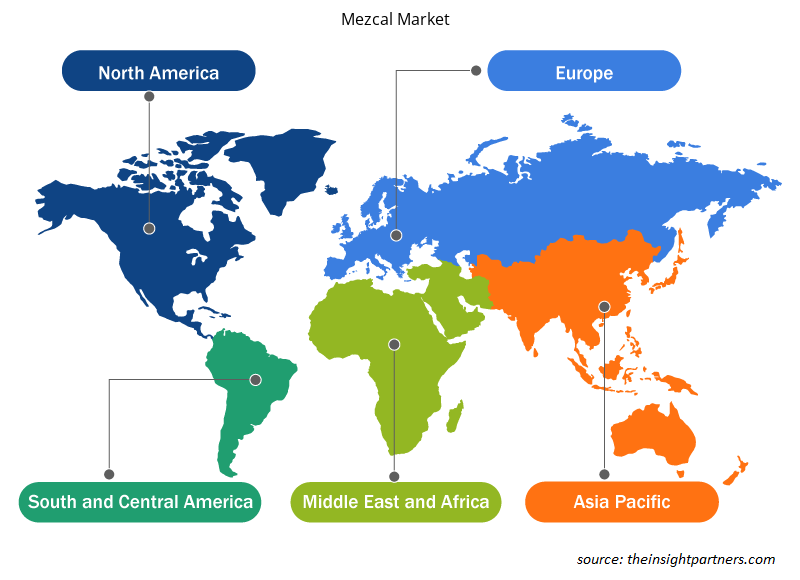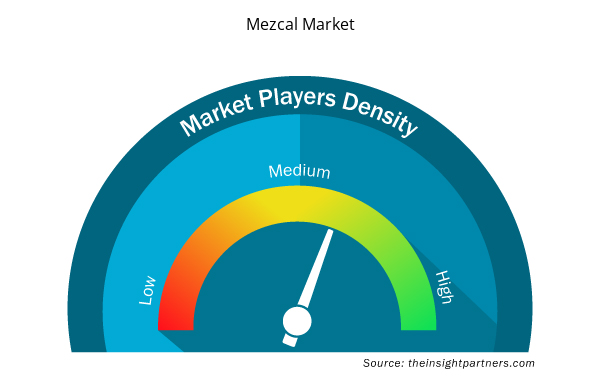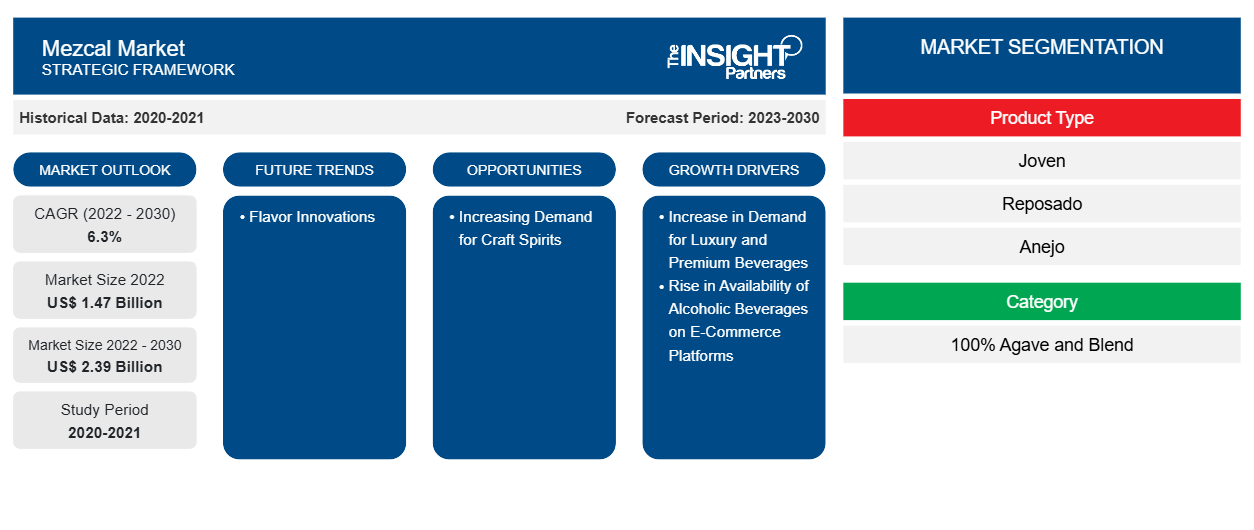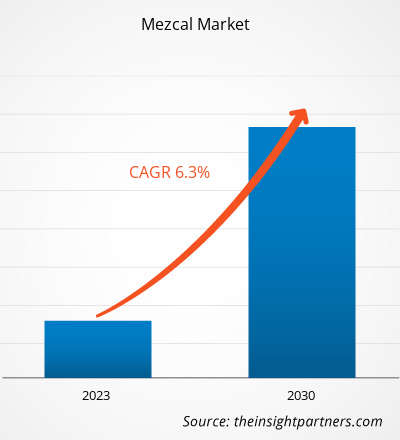[Rapporto di ricerca] La dimensione del mercato del mezcal è stata valutata a 1.469,17 milioni di dollari nel 2022 e si prevede che raggiungerà i 2.393,57 milioni di dollari entro il 2030; si stima che registrerà un CAGR del 6,3% dal 2022 al 2030.
Approfondimenti di mercato e punto di vista degli analisti:
Il mezcal è un liquore messicano distintivo ricavato da piante di agave, principalmente nella regione di Oaxaca. A differenza della tequila, che è un tipo di mezcal ricavato esclusivamente da agave blu, il mezcal può essere prodotto da varie specie di agave, il che gli conferisce una gamma più ampia di sapori e aromi. L'aumento della domanda di mezcal può essere attribuito ai suoi metodi di produzione artigianali, al sapore affumicato unico e al crescente apprezzamento per i liquori artigianali. I consumatori cercano sempre più autenticità e diversità nelle loro esperienze di consumo, il che ha portato il mezcal a guadagnare popolarità tra gli amanti dei liquori avventurosi e i mixologist. Anche il suo patrimonio culturale e le tecniche di produzione tradizionali hanno contribuito al suo fascino, rendendolo una scelta ricercata per coloro che desiderano esplorare il ricco mondo dei liquori a base di agave.
Fattori di crescita e sfide:
La crescente domanda di bevande di lusso e premium è emersa come forza trainante per il mercato del Mezcal. Un catalizzatore significativo per questa tendenza è l'aumento del reddito disponibile dei consumatori. Con l'aumento dei guadagni delle persone, sono più inclini ad allocare una parte del loro budget per concedersi liquori di alta qualità come il Mezcal. Ciò ha aperto opportunità per i marchi premium di Mezcal di prosperare poiché i consumatori cercano esperienze di consumo distintive ed elevate. Inoltre, l'influenza dei millennial non può essere sottovalutata. Questa coorte demografica ha mostrato una particolare inclinazione a spendere in bevande di alta qualità, guidata dal desiderio di qualità, autenticità e profili di sapore unici. Il Mezcal si allinea perfettamente a queste preferenze, offrendo un prodotto artigianale e artigianale che risuona con la fascia demografica dei millennial, contribuendo in modo significativo all'aumento della domanda.
Personalizza questo report in base alle tue esigenze
Riceverai la personalizzazione gratuita di qualsiasi report, comprese parti di questo report, o analisi a livello nazionale, pacchetto dati Excel, oltre a usufruire di grandi offerte e sconti per start-up e università
- Scopri le principali tendenze di mercato in questo rapporto.Questo campione GRATUITO includerà analisi di dati che spaziano dalle tendenze di mercato alle stime e alle previsioni.
Inoltre, l'evoluzione delle preferenze dei consumatori gioca un ruolo fondamentale nel guidare il mercato del Mezcal. I consumatori moderni cercano sempre più liquori unici e sofisticati che vadano oltre l'ordinario. Con il suo intricato processo di produzione, note affumicate e sapori distinti, il Mezcal si allinea bene con questo cambiamento. È diventato un simbolo di gusto raffinato e si è guadagnato la reputazione di scelta di bevande premium, attraendo consumatori esigenti alla ricerca di un'esperienza di consumo più elevata.
La fiorente cultura dei cocktail ha ulteriormente contribuito all'ascesa del Mezcal nel mercato delle bevande di lusso. Mixologist e baristi hanno accolto il Mezcal come ingrediente versatile e di prima qualità per creare cocktail unici e innovativi. I suoi sapori affumicati e complessi aggiungono profondità e carattere ai drink, rendendolo una scelta ricercata nei bar e nei ristoranti di lusso. Ciò ha accresciuto la visibilità del Mezcal e stimolato l'interesse dei consumatori nel ricreare queste esperienze di cocktail di lusso a casa, stimolando ulteriormente la domanda.
Infine, la percezione del Mezcal come prodotto di lusso è stata amplificata da efficaci strategie di marketing e packaging distintivo. I marchi di Mezcal premium hanno investito in un branding sofisticato che evidenzia le origini artigianali del prodotto, enfatizzandone l'esclusività. Questo approccio di marketing ha attratto consumatori alla ricerca di status symbol e opzioni regalo uniche, rafforzando la domanda di Mezcal nel mercato degli alcolici di lusso.
Tuttavia, ci sono rigide normative che regolano la produzione, l'etichettatura e la certificazione del Mezcal in Messico. La Denominazione di Origine del Mezcal, che protegge l'origine geografica del Mezcal e i metodi di produzione tradizionali, impone una serie di regole che possono essere gravose per i produttori. Ad esempio, per essere etichettato come "Mezcal", il liquore deve essere prodotto da varietà specifiche di piante di agave, che si trovano principalmente in alcune aree del Messico, e prodotto utilizzando metodi tradizionali. Il metodo tradizionale include la cottura in fosse di terra o forni di argilla, la macinatura a mano, la fermentazione in fosse di pietra o organiche e la distillazione con fuoco diretto sotto pentole di rame o argilla. Soddisfare questi requisiti può essere costoso o richiedere molto tempo, limitando la capacità dei produttori più piccoli di entrare nel mercato e competere efficacemente.
Un'altra sfida normativa riguarda la certificazione e l'etichettatura. I produttori devono rispettare rigorosi standard di qualità e sottoporsi a processi di certificazione per portare l'etichetta ufficiale "Mezcal". Questo può rappresentare un ostacolo per i produttori locali più piccoli che potrebbero non avere le risorse per districarsi in queste procedure burocratiche o investire nelle attrezzature e nelle strutture necessarie. Inoltre, le rigide regole sull'etichettatura e la pubblicità includono la specificazione del tipo di agave utilizzato, la regione di produzione e il processo di distillazione. Qualsiasi deviazione da queste regole può portare a problemi legali, rendendo essenziale per i produttori rispettarle meticolosamente. Questi vincoli normativi possono limitare l'ingresso nel mercato, ostacolare l'innovazione e creare costi di conformità, in particolare per i piccoli produttori di Mezcal.
Segmentazione e ambito del report:
Il mercato globale del mezcal è segmentato in base al tipo di prodotto, alla categoria, al canale di distribuzione e alla geografia. In base al tipo di prodotto, il mercato è categorizzato in joven, reposado, anejo e altri. Per categoria, il mercato è biforcato in 100% agave e blend. Per canale di distribuzione, il mercato è categorizzato in supermercati e ipermercati, negozi specializzati, vendita al dettaglio online e altri. Per geografia, il mercato globale del mezcal è ampiamente segmentato in Nord America, Europa, Asia Pacifico, Medio Oriente e Africa e Sud e Centro America.
Analisi segmentale:
In base al tipo di prodotto, il mercato è suddiviso in joven, reposado, anejo e altri. Si prevede che il segmento reposado registrerà il CAGR più elevato nel periodo 2022-2030. Reposado, che in spagnolo significa "riposato", rappresenta una via di mezzo tra l'audacia giovanile di joven e la complessità invecchiata di anejo mezcal. Subisce un processo di invecchiamento relativamente breve, da due mesi a un anno in botti di rovere. Questo invecchiamento conferisce un carattere più morbido allo spirito, attenuando alcuni dei bordi più acuti dell'agave. Pur mantenendo i sapori principali dell'agave, reposado mezcal sviluppa sfumature aggiuntive, come sentori di vaniglia , caramello e legno. La sua crescente domanda è dovuta alla sua capacità di bilanciare la vivacità non invecchiata di joven e la complessità raffinata di anejo, rendendolo la scelta preferita per coloro che cercano un'esperienza di mezcal più fluida e accessibile.
Analisi regionale:
Il mercato del mezcal è suddiviso in cinque regioni chiave: Nord America, Europa, Asia Pacifico, Sud e Centro America e Medio Oriente e Africa. Il Nord America ha dominato il mercato globale del mezcal e il mercato regionale ha rappresentato 612,20 milioni di dollari nel 2022. L'Europa è il secondo maggiore contributore, con una quota di mercato globale superiore al 29%. Si prevede che l'Asia Pacifico registrerà un CAGR considerevole di oltre il 7% nel periodo 2022-2030. Il mezcal sta guadagnando popolarità tra i consumatori nei paesi asiatici come Cina, India, Giappone e Australia. Questo spostamento dei consumatori verso il mezcal è attribuito principalmente alle crescenti preoccupazioni per la salute. La crescente preferenza per le bevande alcoliche di lusso ha aumentato la domanda di mezcal, che si prevede spingerà la crescita del mercato nell'APAC.
Approfondimenti regionali sul mercato del Mezcal
Le tendenze regionali e i fattori che influenzano il mercato del Mezcal durante il periodo di previsione sono stati ampiamente spiegati dagli analisti di Insight Partners. Questa sezione discute anche i segmenti e la geografia del mercato del Mezcal in Nord America, Europa, Asia Pacifico, Medio Oriente e Africa e Sud e Centro America.

- Ottieni i dati specifici regionali per il mercato del Mezcal
Ambito del rapporto sul mercato del Mezcal
| Attributo del report | Dettagli |
|---|---|
| Dimensioni del mercato nel 2022 | 1,47 miliardi di dollari USA |
| Dimensioni del mercato entro il 2030 | 2,39 miliardi di dollari USA |
| CAGR globale (2022-2030) | 6,3% |
| Dati storici | 2020-2021 |
| Periodo di previsione | 2023-2030 |
| Segmenti coperti | Per tipo di prodotto
|
| Regioni e Paesi coperti | America del Nord
|
| Leader di mercato e profili aziendali chiave |
|
Densità dei player del mercato del mezcal: comprendere il suo impatto sulle dinamiche aziendali
Il mercato del Mezcal Market sta crescendo rapidamente, spinto dalla crescente domanda degli utenti finali dovuta a fattori quali l'evoluzione delle preferenze dei consumatori, i progressi tecnologici e una maggiore consapevolezza dei benefici del prodotto. Con l'aumento della domanda, le aziende stanno ampliando le loro offerte, innovando per soddisfare le esigenze dei consumatori e capitalizzando sulle tendenze emergenti, il che alimenta ulteriormente la crescita del mercato.
La densità degli operatori di mercato si riferisce alla distribuzione di aziende o società che operano in un particolare mercato o settore. Indica quanti concorrenti (operatori di mercato) sono presenti in un dato spazio di mercato in relazione alle sue dimensioni o al valore di mercato totale.
Le principali aziende che operano nel mercato del Mezcal sono:
- Casa Agave Ltd
- Quiquiriqui Mezcal Ltd
- Davide Campari Milano NV
- Gente di Mezcal SA di CV
- Bacardi-Martini BV
Disclaimer : le aziende elencate sopra non sono classificate secondo un ordine particolare.

- Ottieni una panoramica dei principali attori del mercato del Mezcal
Impatto della pandemia di COVID-19:
La pandemia di COVID-19 ha inizialmente ostacolato il mercato globale del mezcal a causa della chiusura delle unità produttive, della carenza di manodopera, dell'interruzione delle catene di fornitura e dell'instabilità finanziaria. L'interruzione di vari settori dovuta al rallentamento economico causato dall'epidemia di COVID-19 ha limitato la fornitura di mezcal. Vari negozi di liquori sono stati chiusi. Tuttavia, le attività hanno iniziato a guadagnare terreno poiché le limitazioni precedentemente imposte sono state allentate in vari paesi. Inoltre, l'introduzione dei vaccini COVID-19 da parte dei governi di diversi paesi ha alleviato la situazione, portando a un aumento delle attività commerciali in tutto il mondo. Diversi mercati, incluso il mercato del mezcal, hanno registrato una crescita dopo l'allentamento dei lockdown e delle restrizioni alla circolazione.
Scenario competitivo e aziende chiave:
Tra i principali attori del mercato globale del mezcal figurano Casa Agave Ltd, Quiquiriqui Mezcal Ltd, Davide Campari Milano NV, Gente de Mezcal SA de CV, Bacardi-Martini BV, Diageo Plc, Pernod Ricard SA, Meanwhile Drinks Ltd, Proximo Spirits Inc e Madre Mezcal Inc.
- Analisi storica (2 anni), anno base, previsione (7 anni) con CAGR
- Analisi PEST e SWOT
- Valore/volume delle dimensioni del mercato - Globale, regionale, nazionale
- Industria e panorama competitivo
- Set di dati Excel


- Medical and Research Grade Collagen Market
- Grant Management Software Market
- Visualization and 3D Rendering Software Market
- Nitrogenous Fertilizer Market
- Extracellular Matrix Market
- Print Management Software Market
- Fishing Equipment Market
- E-Bike Market
- Hydrocephalus Shunts Market
- Dry Eye Products Market

Report Coverage
Revenue forecast, Company Analysis, Industry landscape, Growth factors, and Trends

Segment Covered
This text is related
to segments covered.

Regional Scope
North America, Europe, Asia Pacific, Middle East & Africa, South & Central America

Country Scope
This text is related
to country scope.
Domande frequenti
The major players operating in the global mezcal market are Casa Agave Ltd, Quiquiriqui Mezcal Ltd, Davide Campari Milano NV, Gente de Mezcal SA de CV, Bacardi-Martini BV, Diageo Plc, Pernod Ricard SA, Meanwhile Drinks Ltd, Proximo Spirits Inc, and Madre Mezcal Inc among others.
In 2022, North America region accounted for the largest share of the global mezcal market. The North American region comprises developed and developing economies such as the U.S. and Canada, and Mexico. Several mezcal breweries have a strong foothold in the North American region. Key market players in the North American mezcal market include E.L. Silencio Holdings, Inc., Mezcal Vago, Ilegal Mezcal, Rey Campero, and many others. These breweries are constantly working towards innovation and developing different varieties of mezcal with improved tastes and qualities to attract new consumers and widen the consumer base in the region. The export of mezcal to several countries across North America will contribute to the rise in demand for mezcal in the region. Innovative programs aimed at marketing the product across North America will increase demand for mezcal in North America.
The rising demand for luxury and premium beverages has emerged as a driving force for the Mezcal market. One significant catalyst for this trend is the increase in the disposable income of consumers. As people's earnings have grown, they are more inclined to allocate a portion of their budget to indulging in high-end spirits such as Mezcal. This has opened up opportunities for premium Mezcal brands to thrive as consumers seek distinctive, elevated drinking experiences. Additionally, the influence of millennials cannot be understated. This demographic cohort has shown a particular penchant for spending on high-end beverages, driven by a desire for quality, authenticity, and unique flavor profiles. Mezcal aligns perfectly with these preferences, offering a handcrafted and artisanal product that resonates with the millennial demographic, contributing significantly to the surge in demand. Moreover, the evolution of consumer preferences plays a pivotal role in driving the Mezcal market. Modern consumers increasingly seek unique and sophisticated spirits that go beyond the ordinary. With its intricate production process, smoky notes, and distinct flavors, Mezcal aligns well with this shift. It has become a symbol of refined taste and has gained a reputation as a premium beverage choice, attracting discerning consumers looking for a more elevated drinking experience.
Based on product type, the market is categorized into joven, reposado, anejo, and others. The reposado segment is expected to register the highest CAGR during 2022–2030. Reposado, which translates to "rested" in Spanish, represents a middle ground between the youthful boldness of joven and the aged complexity of anejo mezcal. It undergoes a relatively short aging process of two months to one year in oak barrels. This aging imparts a mellower character to the spirit, smoothing out some of the agave's sharper edges. While retaining the core agave flavors, reposado mezcal develops additional nuances, such as hints of vanilla, caramel, and wood. Its surging demand is due to its ability to balance the unaged vibrancy of joven and the refined complexity of anejo, making it a preferred choice for those seeking a smoother and more approachable mezcal experience.
Based on category, the mezcal market is segmented into 100% agave and blend. 100% agave category represents mezcal made exclusively from agave plants, with no other sugar sources added during fermentation or distillation. It embodies the traditional and authentic spirit of mezcal production, highlighting various agave species' unique flavors and characteristics. The demand for 100% agave mezcal has been steadily increasing due to consumer's growing appreciation for pure and unadulterated spirits. Discerning drinkers seek the true essence of mezcal, valuing the rich diversity of agave flavors and the dedication of mezcaleros in preserving centuries-old production methods. This category's surge in popularity can be attributed to a desire for transparency and authenticity in the mezcal market as consumers become more educated about the significance of 100% agave labeling.
Mezcal producers are increasingly experimenting with different agave varietals, aging methods, and flavor infusions, which cater to changing consumer preferences and provide unique selling points for their brands. One example of flavor innovation is the use of different agave varieties. While espadin agave is the most commonly used for Mezcal production, some producers explore lesser-known agave types such as tobala, tepextate, and arroqueno. Each agave variety brings its distinct flavor profile to the Mezcal, from earthy and vegetal to fruity and floral notes. This diversity allows consumers to explore various flavors within the Mezcal category, catering to various palate preferences.
Another avenue of innovation involves the aging process. Mezcal aging can occur in various containers, such as oak barrels, glass, or clay pots. Producers experiment with different aging periods and container types to impart unique flavors and aromas. For instance, extended aging in oak barrels can introduce hints of vanilla and caramel, enhancing the complexity of the final product. This approach mirrors the techniques often seen in the whiskey and wine industries, offering a bridge for consumers transitioning from those spirits to Mezcal.
Trends and growth analysis reports related to Food and Beverages : READ MORE..
The List of Companies - Mezcal Market
- Casa Agave Ltd
- Quiquiriqui Mezcal Ltd
- Davide Campari Milano NV
- Gente de Mezcal SA de CV
- Bacardi-Martini BV
- Diageo Plc
- Pernod Ricard SA
- Meanwhile Drinks Ltd
- Proximo Spirits Inc
- Madre Mezcal Inc
The Insight Partners performs research in 4 major stages: Data Collection & Secondary Research, Primary Research, Data Analysis and Data Triangulation & Final Review.
- Data Collection and Secondary Research:
As a market research and consulting firm operating from a decade, we have published and advised several client across the globe. First step for any study will start with an assessment of currently available data and insights from existing reports. Further, historical and current market information is collected from Investor Presentations, Annual Reports, SEC Filings, etc., and other information related to company’s performance and market positioning are gathered from Paid Databases (Factiva, Hoovers, and Reuters) and various other publications available in public domain.
Several associations trade associates, technical forums, institutes, societies and organization are accessed to gain technical as well as market related insights through their publications such as research papers, blogs and press releases related to the studies are referred to get cues about the market. Further, white papers, journals, magazines, and other news articles published in last 3 years are scrutinized and analyzed to understand the current market trends.
- Primary Research:
The primarily interview analysis comprise of data obtained from industry participants interview and answers to survey questions gathered by in-house primary team.
For primary research, interviews are conducted with industry experts/CEOs/Marketing Managers/VPs/Subject Matter Experts from both demand and supply side to get a 360-degree view of the market. The primary team conducts several interviews based on the complexity of the markets to understand the various market trends and dynamics which makes research more credible and precise.
A typical research interview fulfils the following functions:
- Provides first-hand information on the market size, market trends, growth trends, competitive landscape, and outlook
- Validates and strengthens in-house secondary research findings
- Develops the analysis team’s expertise and market understanding
Primary research involves email interactions and telephone interviews for each market, category, segment, and sub-segment across geographies. The participants who typically take part in such a process include, but are not limited to:
- Industry participants: VPs, business development managers, market intelligence managers and national sales managers
- Outside experts: Valuation experts, research analysts and key opinion leaders specializing in the electronics and semiconductor industry.
Below is the breakup of our primary respondents by company, designation, and region:

Once we receive the confirmation from primary research sources or primary respondents, we finalize the base year market estimation and forecast the data as per the macroeconomic and microeconomic factors assessed during data collection.
- Data Analysis:
Once data is validated through both secondary as well as primary respondents, we finalize the market estimations by hypothesis formulation and factor analysis at regional and country level.
- Macro-Economic Factor Analysis:
We analyse macroeconomic indicators such the gross domestic product (GDP), increase in the demand for goods and services across industries, technological advancement, regional economic growth, governmental policies, the influence of COVID-19, PEST analysis, and other aspects. This analysis aids in setting benchmarks for various nations/regions and approximating market splits. Additionally, the general trend of the aforementioned components aid in determining the market's development possibilities.
- Country Level Data:
Various factors that are especially aligned to the country are taken into account to determine the market size for a certain area and country, including the presence of vendors, such as headquarters and offices, the country's GDP, demand patterns, and industry growth. To comprehend the market dynamics for the nation, a number of growth variables, inhibitors, application areas, and current market trends are researched. The aforementioned elements aid in determining the country's overall market's growth potential.
- Company Profile:
The “Table of Contents” is formulated by listing and analyzing more than 25 - 30 companies operating in the market ecosystem across geographies. However, we profile only 10 companies as a standard practice in our syndicate reports. These 10 companies comprise leading, emerging, and regional players. Nonetheless, our analysis is not restricted to the 10 listed companies, we also analyze other companies present in the market to develop a holistic view and understand the prevailing trends. The “Company Profiles” section in the report covers key facts, business description, products & services, financial information, SWOT analysis, and key developments. The financial information presented is extracted from the annual reports and official documents of the publicly listed companies. Upon collecting the information for the sections of respective companies, we verify them via various primary sources and then compile the data in respective company profiles. The company level information helps us in deriving the base number as well as in forecasting the market size.
- Developing Base Number:
Aggregation of sales statistics (2020-2022) and macro-economic factor, and other secondary and primary research insights are utilized to arrive at base number and related market shares for 2022. The data gaps are identified in this step and relevant market data is analyzed, collected from paid primary interviews or databases. On finalizing the base year market size, forecasts are developed on the basis of macro-economic, industry and market growth factors and company level analysis.
- Data Triangulation and Final Review:
The market findings and base year market size calculations are validated from supply as well as demand side. Demand side validations are based on macro-economic factor analysis and benchmarks for respective regions and countries. In case of supply side validations, revenues of major companies are estimated (in case not available) based on industry benchmark, approximate number of employees, product portfolio, and primary interviews revenues are gathered. Further revenue from target product/service segment is assessed to avoid overshooting of market statistics. In case of heavy deviations between supply and demand side values, all thes steps are repeated to achieve synchronization.
We follow an iterative model, wherein we share our research findings with Subject Matter Experts (SME’s) and Key Opinion Leaders (KOLs) until consensus view of the market is not formulated – this model negates any drastic deviation in the opinions of experts. Only validated and universally acceptable research findings are quoted in our reports.
We have important check points that we use to validate our research findings – which we call – data triangulation, where we validate the information, we generate from secondary sources with primary interviews and then we re-validate with our internal data bases and Subject matter experts. This comprehensive model enables us to deliver high quality, reliable data in shortest possible time.


 Ottieni un campione gratuito per questo repot
Ottieni un campione gratuito per questo repot